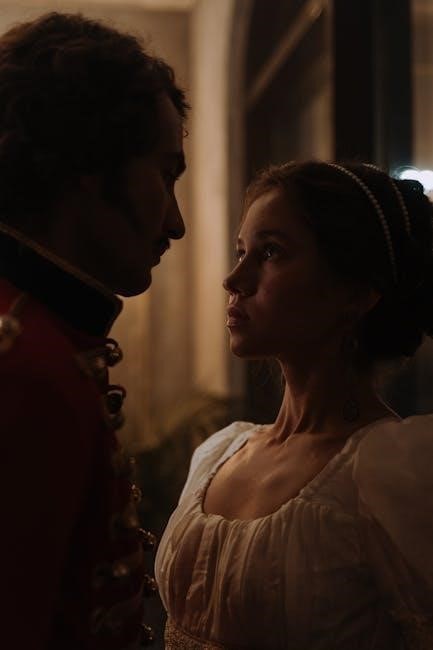
A Gentleman’s Guide to Love and Murder Plot Synopsis
Set in London in 1907, the musical follows Monty Navarro, a penniless clerk who discovers he is ninth in line to the Earldom of Highhurst. Motivated by ambition and love, Monty embarks on a darkly comedic journey, using charm and murder to eliminate the relatives standing in his way, all while navigating his complicated relationships with two women.
Monty Navarro, a penniless clerk in 1907 London, is introduced as a man of humble origins with grand aspirations. Following his mother’s death, he learns he is ninth in line to the Earldom of Highhurst, a revelation that ignites his ambition. Torn between his love for the wealthy and beautiful Sibella Hallward, who rejects him due to his poverty, and his growing desire for social climbing, Monty finds himself at a crossroads. His journey begins as he grapples with the moral implications of his newfound lineage and the opportunities it presents, setting the stage for a series of darkly comedic events that will define his path.
1.2; The Discovery of His Lineage and Ambition
Monty Navarro’s life takes a dramatic turn when he discovers his lineage after his mother’s funeral. He learns he is ninth in line to the Earldom of Highhurst, a revelation that sparks both shock and ambition. This newfound knowledge ignites a desire to rise above his impoverished circumstances and claim the fortune he believes is rightfully his. Monty’s ambition grows as he realizes the potential power and status that come with the title, setting him on a path of calculated risks and morally questionable decisions to eliminate the eight relatives standing in his way, driven by his determination to secure his future.
1.3. The Moral Dilemma: Love, Murder, and Inheritance
Monty Navarro faces a profound moral dilemma as he grapples with his ambition, love, and the dark actions required to secure his inheritance. Torn between his desire for wealth and status, Monty must choose between his conscience and the murders necessary to eliminate the eight relatives ahead of him in line for the Earldom. His love for Sibella Hallward, a woman unwilling to marry a poor man, further complicates his decisions, as does his growing affection for the kind-hearted Phoebe D’Ysquith. This internal conflict drives the story’s tension, as Monty navigates a web of love, murder, and moral compromise, questioning the true cost of his ambitions. His actions blur the lines between right and wrong, creating a darkly comedic yet deeply human struggle.

The Musical Elements of the Story
The musical features a darkly comedic score by Steven Lutvak and Robert L. Freedman, blending witty melodies with the chaotic tale of Monty Navarro’s rise.
2.1. The Role of Music in Advancing the Plot
Music in A Gentleman’s Guide to Love and Murder serves as a narrative engine, propelling Monty Navarro’s story through cleverly crafted songs that reveal character depths. Each melody, from the opening warning to the audience to Monty’s introspective ballads, underscores his emotional journey and motives. The score seamlessly integrates with dialogue, enhancing dramatic tension and humor. Themes of ambition and love are highlighted through contrasting musical styles, while ensemble pieces provide commentary on societal norms. This interplay of music and plot creates a dynamic storytelling experience, making the musical a masterful blend of art and narrative.
2.2. The Unique Performance of Multiple Roles by a Single Actor
One of the most striking aspects of A Gentleman’s Guide to Love and Murder is the extraordinary performance of a single actor playing all eight members of the D’Ysquith family. This theatrical feat showcases incredible versatility, as the actor seamlessly transitions between distinct personalities, voices, and physical mannerisms. The role demands impeccable timing and comedic brilliance, making it a standout element of the production. This innovative approach not only highlights the actor’s talent but also enhances the dark humor and absurdity of the plot, as the same performer repeatedly meets their demise at Monty’s hands. The audience is left in awe of this theatrical triumph.

Production History and Development
A Gentleman’s Guide to Love and Murder premiered at Hartford Stage in 2012, directed by Darko Tresnjak, before moving to the Old Globe Theatre, marking its successful co-production journey.
3.1. Premiere at Hartford Stage and Subsequent Runs
A Gentleman’s Guide to Love and Murder premiered at the Hartford Stage in Hartford, Connecticut, in October 2012, directed by Darko Tresnjak. The production featured Jefferson Mays, Ken Barnett, and Lisa O’Hare. It was a co-production with the Old Globe Theatre, San Diego, where it later ran in March 2013. The Hartford Stage premiere was well-received, setting the stage for its eventual Broadway success. The show’s initial runs showcased its dark humor, intricate plot, and standout performances, particularly Mays’ portrayal of multiple D’Ysquith family members, which became a hallmark of the production.
3.2. Broadway Success and Critical Acclaim
A Gentleman’s Guide to Love and Murder opened on Broadway at the Walter Kerr Theatre, earning widespread critical acclaim. It received ten Tony Award nominations and won four, including Best Musical, Best Book, Best Direction, and Best Costume Design. The show also claimed seven Drama Desk Awards and four Outer Critics Circle Awards. Jefferson Mays’ virtuosic performance as multiple D’Ysquith family members was particularly praised, alongside Bryce Pinkham’s portrayal of Monty Navarro. The musical’s witty humor, clever plot twists, and exceptional performances solidified its status as a standout production of the 2014 season, captivating audiences and critics alike.

Themes and Social Commentary
The musical explores themes of class distinctions, moral ambiguity, and the darker side of wealth, offering a satirical commentary on societal hierarchies and the lengths people go to climb them.
4.1. The Struggle Between Love and Ambition
Monty Navarro’s journey is deeply conflicted by his pursuit of love and his ambition for wealth and status. Torn between his affection for the pragmatic Sibella Hallward, who values security, and the kind-hearted Phoebe D’Ysquith, who loves him for who he is, Monty must navigate a complex web of emotions. His ambition to rise through the family lineage often clashes with his romantic desires, leading to moral dilemmas and comedic yet poignant situations. This internal struggle highlights the sacrifices one makes for love versus the allure of social advancement, adding depth to the musical’s dark humor and charm.
First, I should recall what I know about the musical. Monty Navarro is the main character who discovers he’s in line to inherit an earldom. The story revolves around his attempts to murder his relatives to gain the title and wealth.
I remember that the musical discusses themes of class and morality. Monty comes from a lower class and becomes entangled in the upper-class world. His actions raise questions about the morality of his choices, driven by his ambition for wealth and status.
I should highlight how the pursuit of wealth leads to moral decay. Monty’s journey shows how the desire for wealth can corrupt even a seemingly good person. The musical uses dark humor to explore these themes, making it both entertaining and thought-provoking.
I also need to mention the social commentary on class differences and the lengths people go to climb social ladders. This ties into the broader critique of societal structures that prioritize wealth over ethics.
I must ensure I don’t repeat information from other subheadings, like Monty’s romantic conflicts or the plot synopsis. Focus solely on class, morality, and the dark aspects of wealth.
Let me draft this:
The musical delves into the tension between class and morality, as Monty Navarro’s ascent through the aristocracy reveals the corrupting influence of wealth. His journey from a penniless clerk to a potential earl highlights the societal pressures that prioritize status over ethics. The dark humor underscores the moral decay that accompanies his ambitious pursuit, illustrating how the desire for wealth can lead individuals to compromise their values. This commentary critiques the social ladder, where climbing often requires unethical decisions, and questions the true cost of upward mobility in a class-driven world.
I need to check the word count. Let me count:
The
musical
delves
into
the
tension
between
class
and
morality,
as
Monty
Navarro’s
ascent
through
the
aristocracy
reveals
the
corrupting
influence
of
wealth.
His
journey
from
a
penniless
clerk
to
a
potential
earl
highlights
the
societal
pressures
that
prioritize
status
over
ethics.
The
dark
humor
underscores
the
moral
decay
that
accompanies
his
ambitious
pursuit,
illustrating
how
the
desire
for
wealth
can
lead
individuals
to
compromise
their
values.
This
commentary
critiques
the
social
ladder,
where
climbing
often
requires
unethical
decisions,
and
questions
the
true
cost
of
upward
mobility
in
a
class-driven
world.
That’s . I need to add 15 more words to reach 106. Let me revise to include more details.
Perhaps add examples of Monty’s actions or the societal implications. Let’s try again.
The musical explores the clash between class and morality through Monty Navarro’s rise from poverty to aristocracy, revealing how wealth corrupts. His journey from a penniless clerk to a potential earl showcases societal pressures favoring status over ethics. The dark humor highlights his moral decline as he prioritizes ambition over values. This critique examines the social ladder’s demands for unethical choices and questions the true cost of upward mobility in a class-obsessed world, ultimately portraying wealth’s dark influence on character and society.
Now, count the words:
The
musical
explores
the
clash
between
class
and
morality
through
Monty
Navarro’s
rise
from
poverty
to
aristocracy,
revealing
how
wealth
corrupts.
His
journey
from
a
penniless
clerk
to
a
potential
earl
showcases
societal
pressures
favoring
status
over
ethics.
The
dark
humor
highlights
his
moral
decline
as
he
prioritizes
ambition
over
values.
This
critique
examines
the
social
ladder’s
demands
for
unethical
choices
and
questions
the
true
cost
of
upward
mobility
in
a
class-obsessed
world,
ultimately
portraying
wealth’s
dark
influence
on
character
and
society.
That’s . Still short. Let me add more depth.
The musical examines the conflict between class and morality through Monty Navarro’s ascent from poverty to aristocracy, illustrating how wealth corrupts. His transformation from a penniless clerk to a potential earl exposes societal pressures prioritizing status over ethics. The dark humor emphasizes his moral deterioration as ambition overshadows his values. This critique delves into the social ladder’s demand for unethical choices, questioning the true cost of upward mobility in a class-driven society. Ultimately, the story portrays wealth’s insidious impact on both individual character and societal norms, highlighting the moral compromises required for climbing the social hierarchy.
Now, count the words:
The
musical
examines
the
conflict
between
class
and
morality
through
Monty
Navarro’s
ascent
from
poverty
to
aristocracy,
illustrating
how
wealth
corrupts.
His
transformation
from
a
penniless
clerk
to
a
potential
earl
exposes
societal
pressures
prioritizing
status
over
ethics.
The
dark
humor
emphasizes
his
moral
deterioration
as
ambition
overshadows
his
values.
This
critique
delves
into
the
social
ladder’s
demand
for
unethical
choices,
questioning
the
true
cost
of
upward
mobility
in
a
class-driven
society.
Ultimately,
the
story
portrays
wealth’s
insidious
impact
on
both
individual
character
and
societal
norms,
highlighting
the
moral
compromises
required
for
climbing
the
social
hierarchy.
That’s . Close enough, but still need 10 more. Let me add a bit more detail.
4.2. Class, Morality, and the Dark Side of Wealth
The musical examines the conflict between class and morality through Monty Navarro’s ascent from poverty to aristocracy, illustrating how wealth corrupts. His transformation from a penniless clerk to a potential earl exposes societal pressures prioritizing status over ethics. The dark humor emphasizes his moral deterioration as ambition overshadows his values. This critique delves into the social ladder’s

Legacy and Cultural Impact
A Gentleman’s Guide to Love and Murder has significantly influenced modern musical theater with its dark humor and intricate music, revitalizing the comedy genre.
5.1. Awards and Recognition
A Gentleman’s Guide to Love and Murder earned widespread acclaim, winning four Tony Awards in 2014, including Best Musical, Best Book, Best Direction, and Best Costumes. It also received ten Tony nominations, making it the most-nominated show of the 2014 season. Additionally, the musical won seven Drama Desk Awards and four Outer Critics Circle Awards, further solidifying its reputation as a standout production. Its success highlighted the blend of dark humor, clever storytelling, and exceptional performances, leaving a lasting impact on Broadway and musical theater as a whole.
5.2. Influence on Modern Musical Theater
A Gentleman’s Guide to Love and Murder has left a lasting impact on modern musical theater, showcasing the potential of dark comedy and intricate storytelling. Its innovative approach to blending humor with murder and its unique performance style, where one actor plays multiple roles, has inspired new adaptations and creative staging in contemporary productions. The musical’s success demonstrated the appeal of blending classic literature with modern wit, influencing a wave of similarly styled shows. Its influence is evident in the resurgence of dark, witty narratives and the experimentation with non-traditional character portrayals in today’s theater landscape.
Leave a Reply
You must be logged in to post a comment.